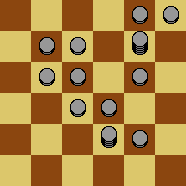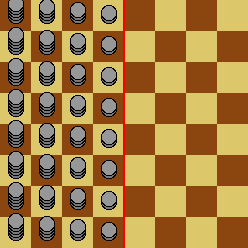Problem 664
An infinite game
Peter is playing a solitaire game on an infinite checkerboard, each square of which can hold an unlimited number of tokens.
Each move of the game consists of the following steps:
- Choose one token $T$ to move. This may be any token on the board, as long as not all of its four adjacent squares are empty.
- Select and discard one token $D$ from a square adjacent to that of $T$.
- Move $T$ to any one of its four adjacent squares (even if that square is already occupied).

The board is marked with a line called the dividing line. Initially, every square to the left of the dividing line contains a token, and every square to the right of the dividing line is empty:

Peter’s goal is to get a token as far as possible to the right in a finite number of moves. However, he quickly finds out that, even with his infinite supply of tokens, he cannot move a token more than four squares beyond the dividing line.
Peter then considers starting configurations with larger supplies of tokens: each square in the $d$th column to the left of the dividing line starts with $d^n$ tokens instead of $1$. This is illustrated below for $n=1$:

Let $F(n)$ be the maximum number of squares Peter can move a token beyond the dividing line. For example, $F(0)=4$. You are also given that $F(1)=6$, $F(2)=9$, $F(3)=13$, $F(11)=58$ and $F(123)=1173$.
Find $F(1234567)$.
无限游戏
彼得在玩一个单人游戏,这个游戏需要一张无穷大的棋盘,棋盘上的每一格都可以放置无限枚棋子。
游戏中的每次行动由以下几个步骤构成:
- 选择一枚棋子$T$,这枚棋子的四个相邻方格不能全部为空。
- 从与$T$相邻的方格中选择并移除一枚棋子$D$。
- 将$T$移动至四个相邻方格之一(棋子可以堆叠)。

棋盘上画有一条竖直线,称为分割线。游戏开始时,在分割线左侧的每一格中放上一枚棋子,而分割线右侧的每一格置空。

彼得的目标是,在有限步内,将一枚棋子移动到分割线右侧尽可能远处。然而,他很快发现,即使他有无限枚棋子,他也只能将一枚棋子向右移动至多四格。
于是彼得转而考虑增加初始局面下棋子的数目:在从分割线向左数第$d$列的所有格子中,一开始放上$d^n$枚而不是$1$枚棋子。如下图所示为$n=1$时的初始局面:

记$F(n)$为此时彼得能够移动棋子到达的最远距离。例如,$F(0)=4$。已知$F(1)=6$,$F(2)=9$,$F(3)=13$,$F(11)=58$,$F(123)=1173$。
求$F(1234567)$。